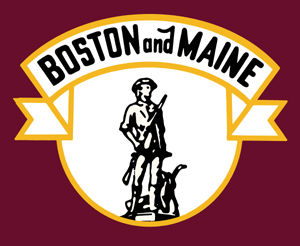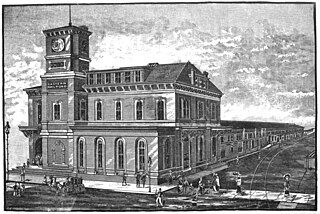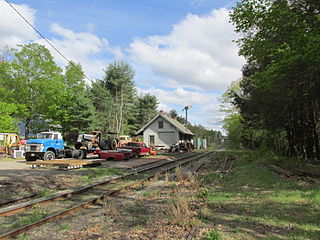
The Boston and Maine Railroad was a U.S. Class I railroad in northern New England. Originally chartered in 1835, it became part of what was the Pan Am Railways network in 1983.

North Station is a commuter rail and intercity rail terminal station in Boston, Massachusetts. It is served by four MBTA Commuter Rail lines – the Fitchburg Line, Haverhill Line, Lowell Line, and Newburyport/Rockport Line – and the Amtrak Downeaster intercity service. The concourse is located under the TD Garden arena, with the platforms extending north towards drawbridges over the Charles River. The eponymous subway station, served by the Green Line and Orange Line, is connected to the concourse with an underground passageway.

The Boston and Lowell Railroad was a railroad that operated in Massachusetts in the United States. It was one of the first railroads in North America and the first major one in the state. The line later operated as part of the Boston and Maine Railroad's Southern Division.

The Lowell Line is a railroad line of the MBTA Commuter Rail system, running north from Boston to Lowell, Massachusetts. Originally built as the New Hampshire Main Line of the Boston & Lowell Railroad and later operated as part of the Boston & Maine Railroad's Southern Division, the line was one of the first railroads in North America and the first major one in Massachusetts.

The Fitchburg Railroad is a former railroad company, which built a railroad line across northern Massachusetts, United States, leading to and through the Hoosac Tunnel. The Fitchburg was leased to the Boston and Maine Railroad in 1900. The main line from Boston to Fitchburg is now operated as the MBTA Fitchburg Line; Pan Am Railways runs freight service on some other portions.
The Central Massachusetts Railroad was a railroad in Massachusetts. The eastern terminus of the line was at North Cambridge Junction where it split off from the Middlesex Central Branch of the Boston and Lowell Railroad in North Cambridge and through which it had access to North Station in Boston. From there, the route ran 98.77 miles west through the modern-day towns of Belmont, Waltham, Weston, Wayland, Sudbury, Hudson, Bolton, Berlin, Clinton, West Boylston, Holden, Rutland, Oakham, Barre, New Braintree, Hardwick, Ware, Palmer, Belchertown, Amherst, and Hadley to its western terminal junction at N. O. Tower in Northampton with the Connecticut River Railroad.
The Lexington and West Cambridge Railroad was a railroad company chartered in 1845 and opened in 1846 that operated in eastern Massachusetts. It and its successors provided passenger service until 1977 and freight service until 1980 or early 1981.

The Eastern Railroad was a railroad connecting Boston, Massachusetts to Portland, Maine. Throughout its history, it competed with the Boston and Maine Railroad for service between the two cities, until the Boston & Maine put an end to the competition by leasing the Eastern in December 1884. Much of the railroad's main line in Massachusetts is used by the MBTA's Newburyport/Rockport commuter rail line, and some unused parts of its right-of-way have been converted to rail trails.

West Concord station is an MBTA Commuter Rail station located in West Concord, Massachusetts. It is served by the Fitchburg Line. The station has two side platforms serving the line's two tracks, with mini-high platforms for accessibility. The adjacent station building, now a restaurant, is not used for railroad purposes.

Ayer station is an MBTA Commuter Rail station located off Main Street in the Ayer Main Street Historic District of Ayer, Massachusetts. It serves the Fitchburg Line. There are three tracks through the station, two of which are served by a pair of low-level side platforms, which are not accessible. There is a shelter on the inbound platform.

Littleton/Route 495 station is an MBTA Commuter Rail station in Littleton, Massachusetts. It serves the Fitchburg Line. The station is located at the intersection of Grimes Lane and Foster Street near Route 2 and I-495 and serves as a park-and-ride station for both highways.

Bedford Depot is a historic railroad depot in Bedford, Massachusetts, United States. Bedford was the junction of the Reformatory Branch and the Lexington Branch of the Boston and Maine Railroad; it saw passenger service until 1977 as the stub of the Lexington Branch. The original 1874 depot and 1877 freight house are listed on the National Register of Historic Places; along with a restored Budd Rail Diesel Car, they form the centerpieces of the Bedford Depot Park.

The Salem and Lowell Railroad, chartered in 1848, was a railroad in Massachusetts that connected the towns of Peabody and Tewksbury. The company connected to other railroads at both ends to provide service to its two namesake cities - the Lowell and Lawrence Railroad at Tewksbury Junction, and the Essex Railroad at Peabody. Construction was completed in 1850, with train operations contracted to the Lowell and Lawrence until 1858, when the Boston and Lowell Railroad took over both companies. In 1887, the Boston and Maine Railroad took over the Boston and Lowell and became the new operator of the Salem and Lowell. The line gradually declined in importance from the start of the 20th century, and was progressively abandoned from 1925 onwards. The last trains ran on the route in 1980, and the remainder of the route formally abandoned in 1987. Parts of the right of way are now a rail-trail.

The Stony Brook Railroad, chartered in 1845, was a railroad company in Massachusetts, United States. The company constructed a rail line between the Nashua and Lowell Railroad's main line at the village of North Chelmsford and the town of Ayer, Massachusetts where it connected to the Fitchburg Railroad. Rather than running its own trains, upon opening in 1848 operations were contracted to the Nashua and Lowell; this arrangement continued until the Nashua and Lowell was leased by the Boston and Lowell Railroad in 1880. The Boston and Maine Railroad (B&M) took over operation of the Stony Brook in 1887 when it leased the Boston and Lowell Railroad. In 1983 the B&M was purchased by Guilford Rail System, which renamed itself Pan Am Railways (PAR) in 2006. Passenger service last ran on the line in 1961, but it saw significant freight service under Pan Am Railways. While it never owned rolling stock or ran trains, the Stony Brook Railroad Corporation existed until 2022 as a nearly wholly owned subsidiary of the Boston and Maine, itself a PAR subsidiary. That year, it was merged into CSX Transportation as part of CSX's purchase of Pan Am Railways.
The Worcester, Nashua and Rochester Railroad was a railroad line that was to link the city of Worcester, Massachusetts, to the city of Portland, Maine, via the New Hampshire cities of Nashua and Rochester, by merging several small shortline railroads together.

The Framingham and Lowell Railroad was a railroad in Middlesex County, Massachusetts. It was incorporated in 1870 to provide a rail connection between the growing railroad hub of Framingham and the important mill city of Lowell, passing through the towns of Sudbury, Concord, Acton, Carlisle, Westford and Chelmsford. The 26.1 mile line opened on October 1, 1871.

The Northern Railroad was a U.S. railroad in central New Hampshire. Originally opened from Concord to West Lebanon in 1847, the Northern Railroad become part of the Boston and Maine system by 1890.

The Boston, Barre and Gardner Railroad was a railroad in Massachusetts that connected Worcester and Winchendon via Gardner. It was originally chartered as the Barre and Worcester Railroad in 1847, before being renamed the Boston, Barre and Gardner Railroad in 1849. The company was unable to raise funds for construction until 1869; service between Worcester and Gardner began in 1871. An extension northward to Winchendon was completed in January 1874. The Boston, Barre and Gardner operated independently until it was taken over by the Fitchburg Railroad in 1885. Despite the company's name, it never served Boston or Barre. The line was abandoned between Winchendon and Gardner in 1959 by the Fitchburg's successor, the Boston and Maine Railroad. In the 21st century, freight service on the remainder of the line is operated by the Providence and Worcester Railroad between Worcester and Gardner, and by Pan Am Railways on a short segment in Gardner.

Railroads have played an important role in New England ever since the Granite Railway, America's first commercial railway, began operations in Massachusetts in 1826. As industrialization spread across the region, hundreds of railroads were built throughout the 19th century. Railroad mileage peaked around World War I, and from that point on mileage began to shrink. Despite this, railroads continue to be important for freight and passenger transportation in the region, with the New Haven Line holding the title of busiest railroad line in the entire United States.

The Nashua and Lowell Railroad (N&L) was a 14-mile-long (23 km) railroad built to connect Nashua, New Hampshire with the city of Lowell, Massachusetts. Chartered in June 1835, construction began in 1837 and the first train ran the next year. The Nashua and Lowell was the first railroad built in the state of New Hampshire.



















